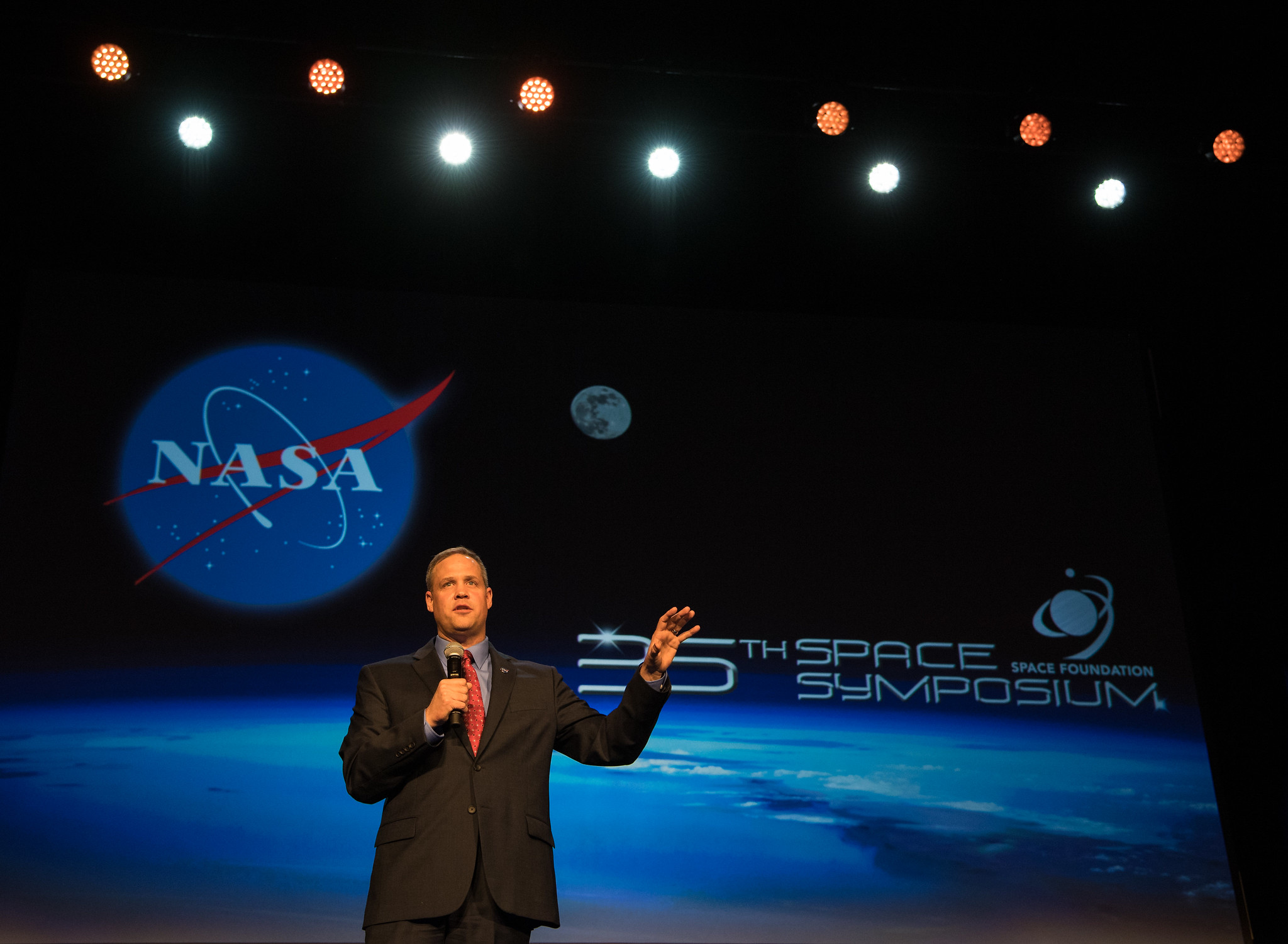Astronauts on the Moon in 2024? US Can't Do It Alone, NASA Chief Says
It's not just flags and footprints.
COLORADO SPRINGS, Colo. — NASA administrator Jim Bridenstine is confident that the agency will be able to land astronauts on the moon in 2024, but the U.S. won't undertake the mission alone, he said during a speech here at the 35th Space Symposium on Tuesday (April 9).
"Putting humans on the moon in 2024 is not an America-alone effort," Bridenstine told a jampacked room of space industry officials. "We need all of our international partners. In fact, none of us can do what we want to achieve alone."
Last month, Vice President Mike Pence announced that President Donald Trump's administration is directing NASA to speed up the timeline for its already-planned moon landing in 2028 to 2024 so that the United States can maintain its position as the leading space superpower of the world — a title that could be threatened by a blooming space race with China and Russia, Pence said at a meeting of the National Space Council on March 26.
Related: Can NASA Really Put Astronauts on the Moon in 2024?

Although NASA faces some international competition in lunar exploration, the agency has seen strong support and interest from international partners. Other countries will likely contribute technology and hardware for NASA's Lunar Orbital Platform-Gateway, a small habitat or space station that would orbit the moon — similar to the way that 15 nations have worked together on the International Space Station for the last 20 years. International partners like the European Space Agency and Japan's space agency, JAXA, have also expressed interest in contributing lunar landers and life-support systems.
The biggest challenge NASA will face in putting astronauts on the moon in 2024 will be funding, Bridenstine told Space.com. "We've got to make sure that we get the budgets necessary to accomplish the objective, which means we need strong bipartisan support — which we're working on really hard right now," Bridenstine said. "Technically, I think it's achievable."
Bridenstine explained that already having some infrastructure in place for the original 2028 target will help make the 2024 landing doable, but the mission will still depend on cooperation with both international and commercial partners.
Get the Space.com Newsletter
Breaking space news, the latest updates on rocket launches, skywatching events and more!
"The plans that we laid out for 2028 are the same plans that we're going to use to get to the moon in 2024. We're just going to have to move forward some of our investments, but it's all achievable," Bridenstine said, adding that a sufficient budget is still "key."
NASA is currently working on an amendment to its fiscal year 2020 budget request, because that budget was issued before Pence announced NASA's accelerated timeline for a moon landing in 2024. Bridenstine did not share any details about what will be in that budget amendment, but he said it will be submitted to the White House Office of Management and Budget next week.
While international partnerships can help alleviate some of the financial burden NASA would face if it had to do everything on its own, those other countries can also benefit from the new lunar infrastructure. Once the lunar gateway is ready, Bridenstine said, NASA and its partners will have "more access to more parts of the moon than ever before." NASA could launch foreign astronauts to the moon, but the agency is committed to making sure that the next man and the first woman on the moon are American, the agency head said.
So, NASA may be leading an effort to build a sustainable human presence on the moon, but the agency couldn't do it without teamwork. "This is all about leadership, and when I say 'leadership,' I'm not talking about the United States of America. I'm talking about leadership with all of our international partners," Bridenstine said in his speech. "We can do this."
- NASA Will Test 5 Habitat Designs for Its Lunar Gateway Space Station
- The Lunar South Pole Is a Rich Target for NASA's 2024 Moon Goal
- NASA's Moon Push Could Help Put Astronauts on Mars by 2033, Chief Says
Email Hanneke Weitering at hweitering@space.com or follow her @hannekescience. Follow us on Twitter @Spacedotcom and on Facebook.
Join our Space Forums to keep talking space on the latest missions, night sky and more! And if you have a news tip, correction or comment, let us know at: community@space.com.

Hanneke Weitering is a multimedia journalist in the Pacific Northwest reporting on the future of aviation at FutureFlight.aero and Aviation International News and was previously the Editor for Spaceflight and Astronomy news here at Space.com. As an editor with over 10 years of experience in science journalism she has previously written for Scholastic Classroom Magazines, MedPage Today and The Joint Institute for Computational Sciences at Oak Ridge National Laboratory. After studying physics at the University of Tennessee in her hometown of Knoxville, she earned her graduate degree in Science, Health and Environmental Reporting (SHERP) from New York University. Hanneke joined the Space.com team in 2016 as a staff writer and producer, covering topics including spaceflight and astronomy. She currently lives in Seattle, home of the Space Needle, with her cat and two snakes. In her spare time, Hanneke enjoys exploring the Rocky Mountains, basking in nature and looking for dark skies to gaze at the cosmos.









